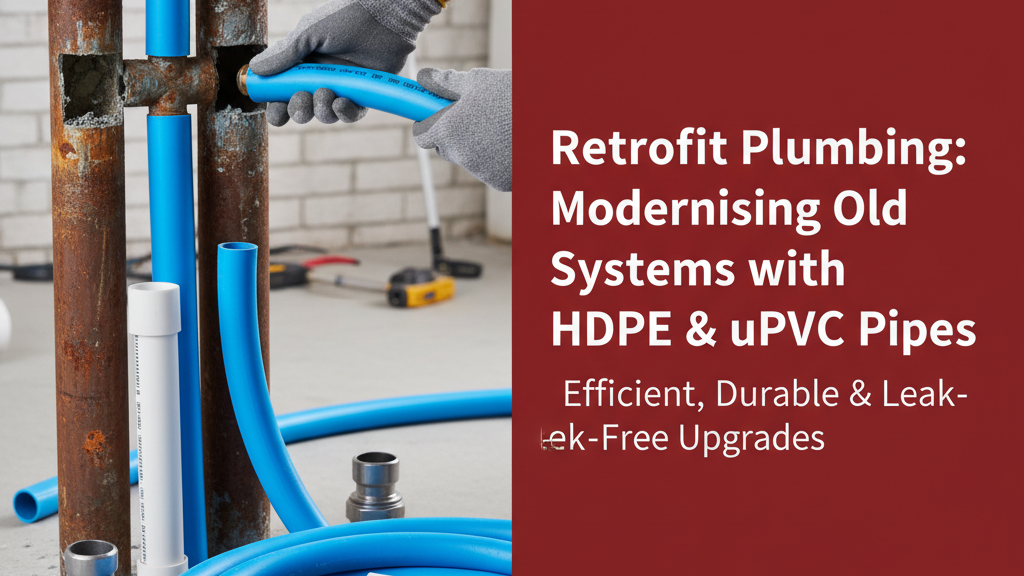Introduction to Retrofit Plumbing
Many Indian homes and buildings still rely on outdated plumbing systems installed decades ago. These ageing networks often suffer from leaks, corrosion, and reduced water pressure. Retrofit plumbing offers a practical solution by replacing old pipes with modern materials like HDPE and uPVC while minimising structural disruption.
Benefits of Upgrading Older Plumbing Systems
Modernising your plumbing delivers measurable improvements:
- Leak reduction: HDPE and uPVC joints are 5-8 times less prone to leakage than traditional threaded metal connections
- Water quality: Non-corrosive materials prevent rust and scale buildup that contaminates supply
- Pressure maintenance: Smooth inner walls maintain flow rates better than corroded metal pipes
- Longevity: Properly installed plastic pipes typically last 50+ years versus 15-25 years for galvanised iron
HDPE Pipes Explained
High-Density Polyethylene (HDPE) pipes are manufactured from thermoplastic polymer granules, creating pipes with unique properties:
- Available in coils (for flexible runs) or straight lengths (for rigid installations)
- Standard diameters from 20mm to 315mm for residential and commercial use
- Operating temperature range: -40°C to 60°C (suitable for most Indian climates)
Durability and Flexibility of HDPE
HDPE’s molecular structure gives it exceptional performance characteristics:
- Bend radius: Can curve up to 25 times the pipe diameter without fittings
- Earthquake resistance: Absorbs ground movement better than rigid pipes
- Chemical resistance: Impervious to salts, acids, and alkalis found in soil and water
- UV stability: Black HDPE pipes contain carbon black for 10+ years of sunlight resistance
uPVC Pipes Explained
Unplasticised Polyvinyl Chloride (uPVC) pipes offer different advantages for retrofit scenarios:
- Rigid construction maintains precise alignment in exposed installations
- Available in pressure classes (PN6 to PN16) for different applications
- Standard diameters from 20mm to 200mm for water supply networks
- Operating temperature range: 0°C to 45°C (optimal for cold water systems)
Advantages of uPVC in Retrofitting
uPVC excels in specific retrofit situations:
- Space efficiency: Thinner walls provide higher flow capacity than metal pipes of the same OD
- Noise reduction: Dampens water hammer noise by 8-12 dB compared to metal pipes
- Fire safety: Self-extinguishing properties meet IS 4985 standards
- Installation speed: Solvent cement joints cure in 15-30 minutes versus hours for threaded joints
HDPE vs. uPVC: Which Should You Choose?
| Factor | HDPE | uPVC |
|---|---|---|
| Best for | Underground, flexible routes, seismic zones | Above-ground, straight runs, tight spaces |
| Joint method | Butt/electrofusion (leak-proof) | Solvent cement (quick curing) |
| Thermal expansion | High (requires expansion loops) | Low (minimal length change) |
| Impact resistance | Excellent (flexes under load) | Good (rigid but brittle at low temps) |
Installation Considerations
Successful retrofits require planning around these factors:
- Access routes: HDPE coils can often be pulled through existing chases without demolition
- Transition fittings: Brass or stainless steel adapters connect new pipes to remaining old sections
- Support spacing: uPVC requires hangers every 0.6-1m versus 1-1.5m for HDPE
- Testing protocol: Always pressure test at 1.5x working pressure for 24 hours
Cost Implications of Retrofitting
While material costs are higher than traditional pipes, plastic systems offer long-term savings:
- Labour savings: 30-50% faster installation reduces man-hours
- Maintenance: Near-zero upkeep versus annual repairs for corroded pipes
- Water savings: 5-7% reduction in losses from eliminated leaks
- Energy efficiency: Smooth interiors reduce pumping energy by 10-15%
Case Studies: Successful Retrofit Projects
Kolkata Heritage Residence: Replaced rusted iron pipes with HDPE using existing chase spaces, completing the 3BHK flat in 2 days without wall damage.
Siliguri Commercial Complex: Switched to uPVC for vertical risers, solving chronic low-pressure issues while gaining 18% more flow capacity in the same shaft space.
Conclusion
Modern HDPE and uPVC piping systems solve multiple pain points in ageing plumbing networks. While each material suits different scenarios, both outperform traditional metals in longevity, water quality preservation, and operational efficiency. The higher initial investment typically pays back within 3-5 years through reduced maintenance and water savings.

